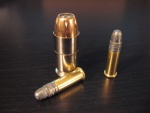Difference between revisions of "Hollow-point bullet"
(→External links) |
m (1 revision) |
Latest revision as of 16:47, 15 March 2013
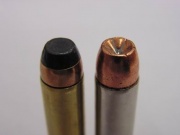
A hollow point, also called a hollow tip, is a bullet that has a pit or hollowed out shape in its tip, generally intended to cause the bullet to expand upon entering a target in order to decrease penetration and disrupt more tissue as it travels through the target. As a side effect, hollow-point bullets can offer improved accuracy by shifting the center of gravity of the bullet rearwards[1]. Jacketed hollow points (JHPs) or plated hollow points are covered in a coating of harder metal to increase bullet strength and to prevent fouling the barrel with lead stripped from the bullet. The term hollow-cavity bullet is used to describe a hollow point where the hollow is unusually large, sometimes dominating the volume of the bullet, and causes extreme expansion or fragmentation on impact[2].
Contents |
[edit] How it works
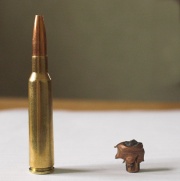
[edit] Expansion
When a hollow-point hunting bullet strikes a soft target the pressure created in the pit forces the material (usually lead) around the inside edge to expand outwards, increasing the axial diameter of the projectile as it passes through. This process is commonly referred to as mushrooming, because the resulting shape, a widened, rounded nose on top of a cylindrical base, typically resembles a mushroom.
The greater frontal surface area of the expanded bullet limits its depth of penetration into the target, and causes more extensive tissue damage along the wound path. Many hollow-point bullets, especially those intended for use at high velocity in centerfire rifles, are jacketed, i.e. a portion of the lead-cored bullet is wrapped in a thin layer of harder metal, such as copper or mild steel. This jacket provides additional strength to the bullet, and can help prevent it from leaving deposits of lead inside the bore. In controlled expansion bullets, the jacket and other internal design characteristics help to prevent the bullet from breaking apart. A fragmented bullet will not penetrate as far and will do less overall damage than one that remains in one piece.
[edit] Accuracy
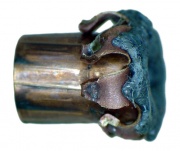

Where target shooting accuracy is the prime consideration, some bullets such as the Sierra "Matchking" incorporate a cavity in the nose section. This has the effect of lightening the bullet's forward section and shifting the center of gravity towards the tail of the bullet, so as to give an improved ballistic coefficient, greater down-range velocity retention, and greater resistance to deflection by crosswinds. Match or target hollow-point bullets are designed for precision target use, and no consideration is given to their expansion or other terminal ballistic performance. The United States military, for example, uses hollow-point bullets in some sniper rifles for their exceptional accuracy at long ranges, and believes that the hollow point does not result in significantly different wounds than full metal jacket ammunition in practice.[3] Some hunters, however, have reported good expansion characteristics and quick, humane kills from hollow-point target bullets.
A boat tail hollow point bullet is a match grade bullet design that uses the concept of a teardrop like shape to give it a lower drag coefficient and make it produce less turbulence in its wake. Only the base of the bullet has a boat tail like shape, the ogive is still pointed, it can also have an open tip for even better accuracy at long ranges.
[edit] Testing
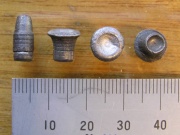
Terminal ballistics testing of hollow-point bullets is generally performed in ballistic gelatin, or some other medium intended to simulate tissue and cause a hollow-point bullet to expand. Test results are generally given in terms of expanded diameter, penetration depth, and weight retention. Expanded diameter is an indication of the size of the wound cavity, penetration depth shows if vital organs could be reached by the bullet, and weight retention indicates how much of the bullet mass fragmented and separated from the main body of the bullet. How these different factors are interpreted is subject to the intended use of the bullet, and what constitutes "good" or "bad" performance is subject to disagreement.
[edit] History
- see also: dum-dum
Solid lead bullets, when cast from a soft alloy, will often deform and provide some expansion if they hit the target at a high velocity. This, combined with the limited velocity and penetration attainable with muzzleloading firearms, meant there was little need for extra expansion.
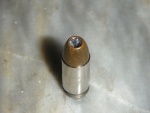
The first hollow-point bullets were marketed in the late 1800s as Express bullets, and were hollowed out to reduce the bullet's mass and provide higher velocities. In addition to providing increased velocities, the hollow also turned out to provide significant expansion, especially when the bullets were cast in a soft lead alloy. Originally intended for rifles, the popular .32-20, .38-40 and .44-40 calibers could also be fired in revolvers. With the advent of smokeless powder, velocities increased, and bullets got smaller, faster, and lighter. These new bullets (especially in rifles) needed to be jacketed to handle the conditions of firing. The new full metal jacket bullets tended to penetrate straight through a target and produce little damage. This led to the development of the soft point bullet and later jacketed hollow-point bullets at the British arsenal in Dum Dum, near Calcutta around 1890. Designs included the .303" Mk III, IV & V and the .455" Mk III "Manstopper" cartridges. Although such bullet designs were quickly outlawed for use in warfare (they breached the terms of the Hague Convention), they steadily gained ground among hunters due to the ability to control the expansion of the new high velocity cartridges. In modern ammunition, the use of hollow points is primarily limited to handgun ammunition, which tends to operate at much lower velocities than rifle ammunition (on the order of 1,000 feet per second (300 m/s) versus over 2,000 feet per second). At rifle velocities, a hollow point is not needed for reliable expansion and most rifle ammunition makes use of tapered jacket designs to achieve the mushrooming effect. At the lower handgun velocities, hollow point designs are generally the only design which will expand reliably.
Modern hollow-point bullet designs use many different methods to provide controlled expansion, including:
- Jackets that are thinner near the front than the rear to allow easy expansion at the beginning, then a reduced expansion rate
- Partitions in the middle of the bullet core to stop expansion at a given point
- Bonding the lead core to the copper jacket to prevent separation and fragmentation
- Fluted or otherwise weakened jackets to encourage expansion or fragmentation
- Posts in the hollow cavity to cause hydraulic expansion of the bullet in tissue. While very effective in lightly clothed targets, these bullet types tend to plug up with heavy clothing materials that results in the bullet not expanding.
- Solid copper hollow points, which are far stronger than jacketed lead, and provide controlled, uniform expansion even at high velocities
- Plastic inserts in the hollow, which provide the same profile as a full metal jacketed round. The plastic insert initiates the expansion of the bullet by being forced into the hollow cavity upon impact.
- Plastic inserts in the hollow to provide the same profile for feeding in semiautomatic and automatic weapons as a full metal jacketed round but that separate on firing while in flight or in the barrel (such as the German Geco "Action Safety" 9 mm round)
[edit] Legality

The Hague Convention of 1899, Declaration III, prohibits the use in warfare of bullets that easily expand or flatten in the body.[4] This is often incorrectly believed to be prohibited in the Geneva Conventions, but it significantly predates those conventions, and is in fact a continuance of the St. Petersburg Declaration of 1868, which banned exploding projectiles of less than 400 grams, and weapons designed to aggravate injured soldiers or make their death inevitable. NATO members do not use small arms ammunition which is prohibited by the Hague Convention.
Despite the ban on military use, hollow-point bullets are one of the most common types of civilian and police ammunition, due largely to the reduced risk of bystanders being hit by over-penetrating or ricocheted bullets, and the increased speed of incapacitation. In many jurisdictions, it is illegal to hunt game with ammunition that does not expand, and some target ranges forbid full metal jacket ammunition. Some indoor shooting ranges prohibit the use of hollow points, as the rounds can create shrapnel.
[edit] United Kingdom
All expanding ammunition, including hollow point bullets, falls under Section 5 (prohibited weapons) of the Firearms Act 1968 and so is illegal to possess or transfer without the written permission of the Home Secretary. However, Section 5A(4) allows the police licensing authority to add a condition to a firearm certificate for possession of expanding ammunition for:
- the lawful shooting of deer
- the shooting of vermin or, in the case of carrying on activities in connection with the management of any estate, other wildlife
- the humane killing of animals
- the shooting of animals for the protection of other animals or humans
The law is in conflict with 'Schedule 2' of 'The Deer Act 1991', prohibiting the use of any ammunition other than soft-nosed or hollow-point bullets for the killing of deer and there have been continuous attempts by shooting organizations to repeal it.
[edit] Winchester Black Talon controversy
In early 1992 Winchester introduced the "Black Talon", a newly designed hollow-point handgun bullet which used a specially designed, reverse tapered jacket. The jacket was cut at the hollow to intentionally weaken it, and these cuts allowed the jacket to open into six petals upon impact. The thick jacket material kept the tips of the jacket from bending as easily as a normal thickness jacket. The slits that weakened the jacket left triangular shapes in the tip of the jacket, and these triangular sections of jacket would end up pointing out after expansion, leading to the "Talon" name. The bullets were coated with a black colored, paint-like lubricant called "Lubalox," and loaded into nickel-plated brass cases, which made them visually stand out from other ammunition. While actual performance of the Black Talon rounds was not significantly better than any other comparable high performance hollow-point ammunition, the reverse taper jacket did provide reliable expansion under a wide range of conditions, and many police departments adopted the round. This cartridge was also known as the "Starpoint".
Winchester's "Black Talon" product name was eventually used against them. After a high profile shooting at 101 California Street, San Francisco in 1993, media response against Winchester was swift. "This bullet kills you better", says one report; "its six razorlike claws unfold on impact, expanding to nearly three times the bullet's diameter".[5][6] A concern was raised by the American College of Emergency Physicians, that the sharp edges of the jacket could penetrate surgical gloves, and increase the risk of blood borne infections being transmitted to medical personnel treating the gunshot wound. While possible, there are no recorded cases of such an infection occurring in relation to the Black Talon bullets.[7]
Winchester responded to the media attacks on the Black Talon line by pulling it from their civilian marketing channels, and selling it only through Winchester law enforcement distributors. They also discontinued applying the black Lubalox coating and renamed the line "Ranger SXT" (The meaning of "SXT" was never explained; a common but false acronym is "Same eXact Thing"). The new jacket's rounded edges had no functional effect on the terminal performance, but addressed the ACEP's concerns about possible dangers to medical personnel.
Even though Winchester voluntarily pulled Black Talon from the civilian market, they were subsequently sued for another 1993 shooting, this one in New York, involving Black Talon ammunition. The suit claimed "negligent manufacture, advertising and marketing of a product that was unreasonably designed and ultrahazardous." However, the court found that "The very purpose of the Black Talon bullet is to kill or cause severe wounding. Here, plaintiffs concede that the Black Talons performed precisely as intended by the manufacturer".[8] Since the bullet was designed to cause rapid incapacitation, and since it performed as expected, the lawsuit was dismissed.
Due to rumor many people believe that the black coating was Teflon, and that it was intended to allow the bullet to penetrate body armor. This was perpetuated by the movie Ronin, in which the character Sam states that the bullet he was shot with was sprayed with Teflon and that is why it penetrated his vest.
[edit] Terminology
The hollow-point bullet, and the soft-nosed bullet, are sometimes also referred to as the dum-dum, so named after the British arsenal at Dum Dum, in present north Kolkata (Calcutta), India, where it is said that jacketed, expanding bullets were first developed. This term is rare among shooters, but can still be found in use, usually in the news media and sensational popular fiction.[9] Recreational shooters sometimes refer to hollow points as "JHPs", from the common manufacturer's abbreviation for "Jacketed Hollow Point".
To be most correct, the term "Dum Dum Bullet" refers only to soft point bullets, not to hollow points, though it is very common for it to be mistakenly used this way.
[edit] See also
[edit] References
- ↑ Barnes Bullets FAQ
- ↑ Barnes Varmint Grenade hollow cavity bullet
- ↑ Memorandum: Sniper Use of Open-Tip Ammunition, W. Hays Parks, Colonel, USMC, Chief of the JAG's International Law Branch, 1985-09-23
- ↑ Declaration III - On the Use of Bullets Which Expand or Flatten Easily in the Human Body, Hague Convention of 1899, 1899-06-29
- ↑ MotherJones SO93: This bullet kills you better Julie Petersen, 1993-09, Mother Jones
- ↑ Winchester Ranger Talon (Ranger SXT/Black Talon) Wound Ballistics Tactical Briefs #2, Firearms Tactical Institute 1998-03-01 "His absurd claim that this bullet gradually expands as it penetrates simply defies the laws of physics, and is based on fantasy."
- ↑ Black Talon: much ado about little, Joe Hallinan, Newhouse News Service, 1995-01-29 Cited in Letter to CNN, Summary of FBI report by Jeff Chan (1995-03-27). RKBA.org "Dr. Stephen Hargarten of Milwaukee, spokesman for the American College of Emergency Physicians stated that to the best of his knowledge no emergency room physicians or medical care providers had ever been cut by the Black Talon round while treating a patient."
- ↑ McCarthy v. Olin Corp., 119 F.3d 148 (2d Cir. 1997).
- ↑ Man who pointed gun at police gets 5 years, Evening Times/Newsquest 2007-03-09 "Police almost shot Steven Bowman, 38, when he was waving a rifle loaded with a dum-dum bullet on a bridge over the M8 in Easterhouse, Glasgow."
[edit] Further reading
- History of commercial hollow-point bullet molds, going back to the 1890s.
- Premium Rifle Bullets: Who Wins The Toughest Test? Precision Shooter, March, 1996. A comparison test of four different .30-06 hollow-point bullets, showing how performance is measured and compared.
[edit] External links
- High speed video clips of several Barnes expanding bullets on impact. The 180 grain .308 bullet shows an ideal mushroom shape in the ballistic gelatin, and clearly shows the ripples in the temporary cavity formed by the spinning bullet.
